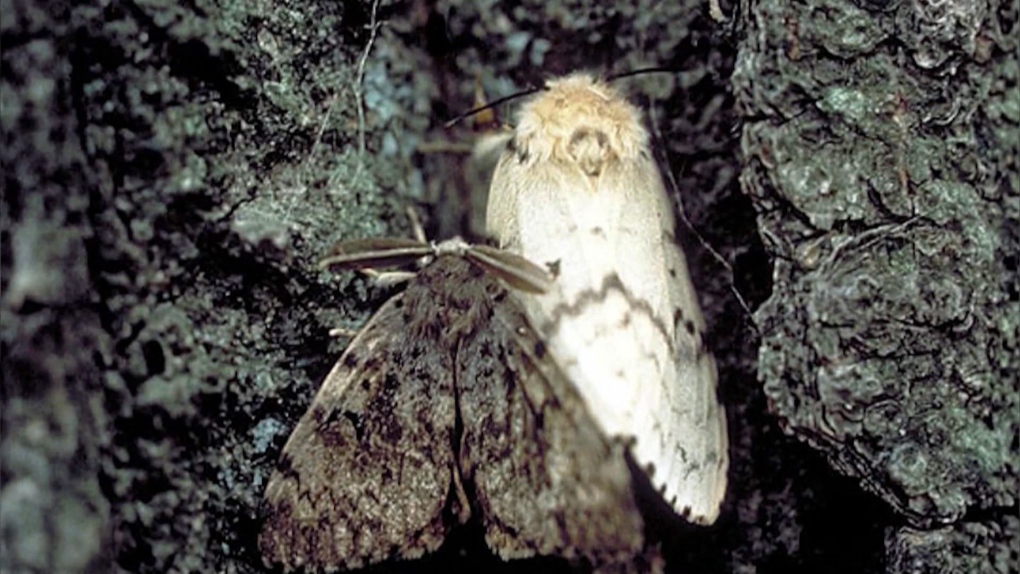Canadian Food Inspection Agency monitoring for spongy moths in Calgary as spring settles in
Federal scientists are busy rolling out another year of pest monitoring equipment meant to protect Alberta's forests and agriculture.
And there are a few new additions around Calgary you might want to watch for.
Hanging here and there around the city are little green boxes.
Please don't touch them - they're a trap.
"There's a sticky substance on the bottom and a pheromone lure inside," said Nicole Brinsmead, an inspection advisor with the Canadian Food Inspection Agency.
The traps are not at all dangerous to people.
They're meant to monitor and prevent a known danger to trees: spongy moths.
"It's an invasive moth," Brinsmead said.
"In the past few years, there have been low levels of detection in Calgary."
 Hanging here and there around the city are little green boxes. They're meant to monitor and prevent a known danger to trees: spongy moths.
Hanging here and there around the city are little green boxes. They're meant to monitor and prevent a known danger to trees: spongy moths.
Brinsmead is tasked with monitoring the invasive moth in southern Alberta.
Her team is laying out roughly 1,200 of these delta-traps through her territory, watching for signs the moths are gaining a toe-hold.
"There's an established population in parts of Ontario, New Brunswick, Nova Scotia and P.E.I.," Brinsmead said.
"There's not an established population in Western Canada."
Any spongy moths currently over-wintering in Alberta are still in their egg phase, clustered on tree trunks, firewood or patio furniture, waiting for spring to actually spring before hatching into pupae.
And then come the caterpillars.
"They'll strip the trees of all of their leaves and kill large amounts of trees, and that can be extremely detrimental to our economy, our forestry, agricultural industries," Brinsmead said.
If you find one of the traps on the ground, don't touch it.
Just call the number on the outside so someone can collect the samples and replace the trap.
CTVNews.ca Top Stories

'Say it to my face': Singh confronts heckling protester on Parliament Hill
NDP Leader Jagmeet Singh confronted a protester for calling him a 'corrupted bastard' on Parliament Hill on Tuesday.
Poilievre's first chance to topple Trudeau government expected next week
Conservative Leader Pierre Poilievre is set to get his first chance to topple Prime Minister Justin Trudeau's minority Liberal government next week, CTV News has confirmed.
Why it's 'very hard' to find work in Canada
Vacancies have steadily fallen since the glut of nearly one million open posts in 2022. At the time, one in three businesses had trouble hiring staff due to a labour shortage. Since then, vacancies have dropped.
Sean 'Diddy' Combs jailed by judge after sex trafficking indictment
Sean 'Diddy' Combs headed to jail Tuesday to await trial in a federal sex trafficking case that accuses him of presiding over a sordid empire of sexual crimes protected by blackmail and shocking acts of violence.
Hezbollah hit by a wave of exploding pagers and blames Israel. At least 9 dead, thousands injured
Pagers used by hundreds of members of the militant group Hezbollah exploded near simultaneously in Lebanon and Syria on Tuesday, killing at least nine people.
Two people charged in murder of Halifax teen; police believe remains have been found
Halifax Regional Police believe Devon Sinclair Marsman, who disappeared in 2022, was the victim of a homicide and two people have now been charged in his death.
Canucks' Dakota Joshua reveals he is recovering from cancer
Vancouver Canucks forward Dakota Joshua revealed Tuesday he underwent cancer treatment over the summer, and will not be ready to play when the team’s training camp begins later this week.
Liberal campaign co-chair calls Montreal byelection loss a 'dry run' for general election
Liberal campaign co-chair Soraya Martinez Ferrada says her party’s Montreal byelection loss — in a riding that has historically been a party stronghold — is a “dry run” for the next general election.
What is racketeering? The crime, explained
Sex trafficking, cheating scandals and mob activity may appear very different. But all fall under the broad umbrella of racketeering.


































